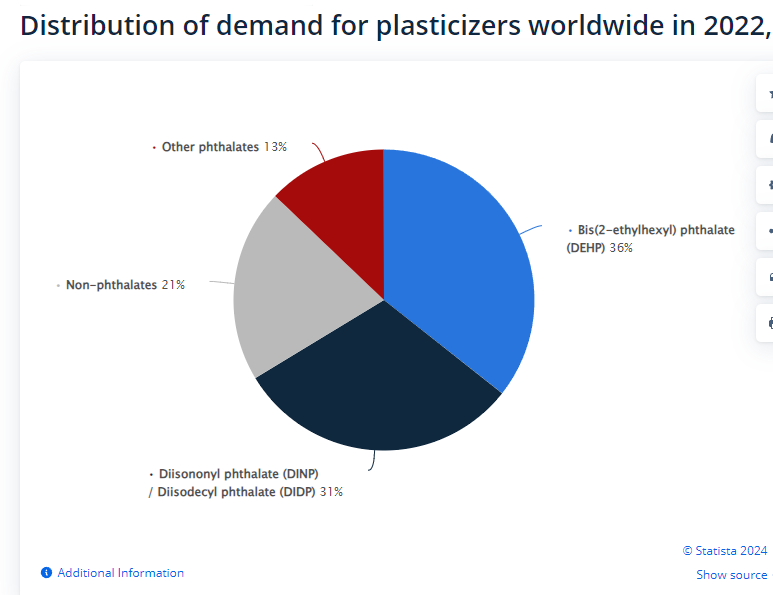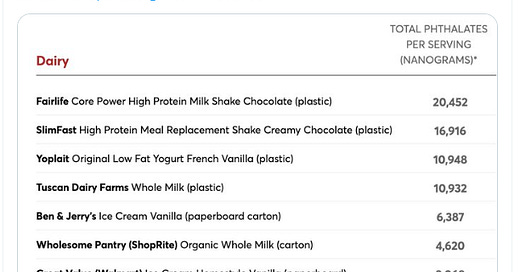Phthalates, Toxic Plastic Additives, are Everywhere: What’s the Acceptable Limit?
I previously covered PFAS, microplastics, benzene. Now looking into phthalates, the minimum risk level limits vs. the likely consumption through foods.
This is a blog where I go in-depth into questions and topics I am personally interested in related to contamination and toxicity. The goal is to break down and interpret the actual data behind many of these compounds in the news for a non-chemist like me. Each blog is based on secondary research, primarily from published articles found through Google Scholar and known academic journals, and experience formed during my work with chemical analysis.
TLDR
Phthalates have recently been in the news for food items containing up to 50 ng per portion;
I went through the available info on CDC and EFSA’s websites and settled on a rule of thumb of 800 µg/day average safe phthalate intake limit;
Our lives are likely edging closer and closer to the currently established safe limits of phthalate consumption. While European data suggests we have not yet breached these safe levels on average, we are moving closer due to many daily sources.
Back at the GCMS lab
Of all the contaminants, phthalates probably inspired me the most to start this blog. When working with an analytical chemistry lab during our work at Volatile AI, I remember them running a contract for phthalate detection. Phthalates are detected by evaporating them into this really precise equipment called gas chromatography - mass spectrometry (GCMS). It turned out to be very hard work because the lab blanks sometimes contained more phthalates than the sample being tested.
That’s because phthalates are everywhere - in lab vials, solvents, and equipment. Despite the fact that the equipment used in a gas chromatography lab is all certified, cleaned, and temperature treated.
That made me wonder - if these guys have an issue even in such a highly controlled environment, I think we as the population overall might have an even bigger issue.
Recent coverage
Always scary to see that the foods we eat contain something we better not have in there. But concentrations are everything - let’s try to understand what phthalates are and how big a concern this is.
What are phthalates?
Phthalates are a family of compounds which are esters with phthalic acid (Wiki). There are lots of them (though perhaps fewer than PFAS?), some notable ones are: DBP, DMP, DEP, DEHP.
In practice, they are plasticizers or solvents found in softer plastics and some household products. When used as plasticizers, higher carbon C4 to C13 phthalates are used, when used as solvents - lower carbon C1 to C3 phthalates are used (Exxon).
When used as a plasticizer, it makes the target material softer and more flexible. Think a kid’s toy which does not break easily or a nail polish which does not crack. Softer plastics containing it are usually PVC or vinyl (pipes, flooring and kids toys) (EWG). And then it’s lots of building and household products: from shower curtains to wires to table clothes to paint, sealants, etc. (Exxon presentation from 2010).
Interestingly, it is also widely used as a solvent - as a base to add other fragrances and properties in cosmetics and soaps. FDA writes that the use of plasticizers, such as DMP, in cosmetics is declining. However, DEP, used as a solvent still remains widely used in cosmetics (FDA, EWG).
Worth knowing - in the US, FDA requires listing phthalate additives in cosmetics and foods, but not all the way down to the chemical name. Thus phthalates added intentionally are typically under the ingredient “fragrance” or “flavor” (FDA).
While phthalates are in the news lately because of their concentrations and health effects, they are still widely used. Exact numbers are not straightforward to find, but at least 65% of plasticizers are said to be phthalates (chart below), while the overall plasticizer market is valued at over $10bn (Source):

Health impacts
It is now widely believed that phthalates are so the called ‘endocrine disruptors’. They can disrupt metabolism, reproductive health and the development of children (Paper). Differently though to PFAS and microplastics, accumulation does not appear to be the primary issue. Phthalates have a short half-life in the body and tend to break down and leave the body through urine, stool or sweat (Paper).
The problem arises when we ingest phthalates every single day in a continuous stream. Primary risks relate to our children: from the development of fetus to birth and into puberty. The following review of available research highlights potential impacts of phthalates on children (not ranked by the risk levels):
Weight (overweight and obesity) and height;
Type II diabetes and insulin resistance;
Thyroid function and increased risk of thyroid cancer;
Higher systolic blood pressure;
Anogenital distance;
Precocious puberty;
Males: genital development, semen quality;
Females: pregnancy and reproductive hormones;
Respiratory system: allergy and asthma;
Nervous system: delayed neurodevelopment, social impairment.
Safe concentration limits for phthalates
Focusing on DEP, which is still widely used as a solvent, an old summary of health impacts from CDC dated 1995 (Source), defines the minimum risk level (MRL) as 6 mg/kg/day, based on rat studies.
Assuming an average person of 80kg of weight (176lbs), that implies a total oral consumption of 480 mg/day or 0.48 g/day. That is rather high and I hope no one is consuming this much of phthalates daily.
In Europe, EFSA has set the following tolerable daily intake limits (amounts which should be harmless for consumption every day throughout life):
DBP, 0.01 mg/kg/day,
BBP, 0.5 mg/kg/day,
DEHP, 0.05 mg/kg/day,
DINP, 0.15 mg/kg/day,
DIDP, 0.15 mg/kg/day.
The lowest of these, DBP, implies the maximum exposure of 0.8 mg/day for an 80kg person. As the impact across different compounds is likely cumulative, to err on the safe side we can assume that 0.8 mg/day or 800 µg/day is the total safe limit across all phthalate intake.
Concentrations in foods
In the recent Consumer Reports research, the number one spot for phthalate content was taken by “Annie’s Organic Cheesy Ravioli (can)”, which apparently contained 53,579 ng of phthalates per portion (does the can contain more than one portion?) (Consumer Reports). That’s a total of ~53 µg → so for a consumer to exceed our established safe limits of 800 µg/day, one should consume over 16 portions per day.
Of course it does not work like that - if every little food item we consume contains this much of phthalates, then we are certainly consuming above the safe limits through the 16 different items per day and other non-food exposure sources.
EFSA estimated the following mean intakes through food (taking the higher bound of the mean values here):
DBP: 0.8 μg/kg/day;
BBP 0.2 μg/kg/day;
DEHP 3.5 μg/kg/day;
DINP 4.3 μg/kg/day;
DIDP 0.1 μg/kg/day.
Adding all of these up, that’s a total of 5.8 μg/kg/day or 460 μg/day for an 80kg person.
That feels about right: on average we are not yet above the safe limit of 800 μg/day, but this also takes into account only the 5 mentioned phthalates out of many more.
There will be a huge person to person variation based on different products consumed and the living environments, just as in the Consumer Reports survey. Not all apples were bad there: the “Polar Seltzer Raspberry Lime (can)” had 0 phthalates (Consumer Reports).
To recap - our lives are likely edging closer and closer to the currently established safe limits of phthalate consumption. While European data suggests we have not yet breached these safe levels on average, we are moving closer due to many daily sources.
There are a few additional elements to the phthalate puzzle: water intake and skin absorption, both of which are issues. I might cover these in future posts.




